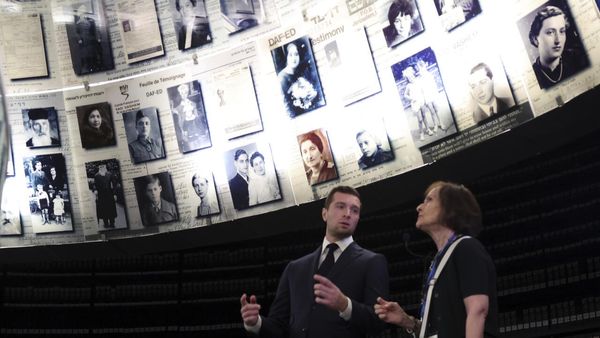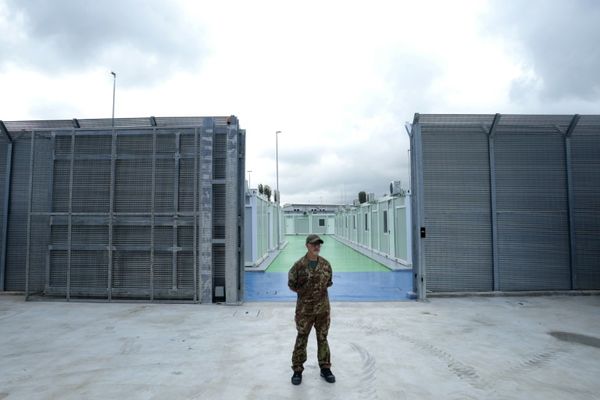
In the first episode of Britain’s Most Expensive Houses, which aired on Channel 4 in December 2021, agents from Sotheby’s International Realty gather for an “urgent meeting” about how to sell Heathfield House: a futuristic, 18,239 sq ft property in Highgate with a £40 million price tag.
It was the ultimate luxury lockdown pad, they agreed, but it would take a very particular type of buyer — one with very deep pockets.
At the time, the house had already been on the market for two years. It was first listed in October 2019, according to Zoopla, with Lee Koffman, then at Sotheby’s International Realty, as agent.
The house has a swimming pool, full spa facilities, a glass lift and a tennis court, and was one of Rightmove’s top 10 most-viewed properties for four years. YouTube video tours of the property have more than 200,000 views.
And yet, five years later, Heathfield House is still on the market. Why?

The build
Walking down Merton Lane, a leafy street which slopes down from Highgate West Hill towards Hampstead Heath, you wouldn’t know Heathfield House exists. The sprawling property is hidden behind a wooden gate, down a 75-metre, tree-lined driveway and set in two acres of private grounds.
“You cannot see this house from the street, which is remarkable,” says Koffman, who is now director and head of residential sales at Robert Irving Burns. “All you see is the brown electric gates.”
The house itself is clad in limestone, with marble banding. The front of the building, with a glass canopy over the entrance and a towering glass column containing the house’s stairwell, looks business-like, with its glass windows and manicured hedges.
The back, much photographed, has a curved façade: half modern Colosseum, half Mi6 headquarters. Separate to the house is five-car garage and self-contained, 4,400 sq ft staff lodge.

This house, planning documents show, was built by a Russian-born businessman in 2002, according to Land Registry records, who demolished the vacant house and guest cottage which originally stood on the site.
“They wanted to make an architectural statement,” says Trevor Abrahmsohn of Glentree Estates, who has also been appointed to find a buyer. “It was a trophy site. They didn’t want to build something mundane, neo-Georgian or Palladian-style. They wanted it to be much more avant-garde.”
The planning application to build a new house on the site was first approved in 1997, three years after it was submitted, and five years before the businessman bought the plot. The build was long and complex, with adjustments still being made to the property and grounds until 2011.
“They wanted to make an architectural statement. It was a trophy site.”
Five architecture firms were involved.
The first, Alan Power Architects, who had a confidentiality clause in their contract, said that once enabling works were completed, an overseas firm was brought in to take the project forward, which included the building’s interior design. Power said: “The exterior of the completed building differs in several significant ways from our initial design.”
An East German project management company were employed to oversee the work. They then engaged a UK firm, Barclay & Phillips Architects, to help with planning compliance.
“The East German project managers had run into real difficulties with planning and building regulations compliance and Nick [Phillips] had tasked me with getting involved and steering these aspects of the project to a successful outcome,” says Steven Bushell, who worked for the firm. Bushell moved on in 2006, before the house was finished.
“There were also several PR presentations carried out by B&P for the local neighbourhood, as there were issues with construction traffic, the scale and massing of the house and loss of several trees.”
Heathfield House today

Today, the finished product has 10 bedrooms — five in the main house; five in the guest lodge — and nine bathrooms.
Abrahmsohn describes it as a “cross between a country estate and a townhouse”. “This has all the trappings of luxury in one place – you don’t have to go anywhere else,” he says. “Effectively, it’s a sort of medium-sized hotel.”
On the lower ground floor is the games room, full leisure suite, which includes a sauna, steam room and gym, and the swimming pool. “The swimming pool is probably the biggest indoor pool I’ve ever come across,” says Koffman. “It’s got glass panels leading out to the garden. And those glass panels go into the ground. It’s very much indoor-outdoor living.”
“The ground floor is very palatial, very ambassadorial. The lower ground floor leisure facilities are the best I’ve ever seen.”
A huge reception room occupies most of the ground floor, with a double-height ceiling in the entrance hall, lined with glass windows. The five bedrooms, all ensuite, are on the first floor, with a study and roof terrace with views over London above. All four storeys are serviced by a glass lift in the middle of the building. Outside, there is a tennis court and landscaped gardens.
“The ground floor is very palatial, very ambassadorial. The lower ground floor leisure facilities are the best I’ve ever seen,” says Koffman. “It’s a very unique house. It cost [the owner] a fortune to do it, with the materials he used: the fantastic marble and onyx; the glass lift. But it is quite specific to his tastes.”
“The plot itself, which is over two acres of land in prime Highgate, is a phenomenal asset,” Koffman adds. “And the other benefit for him, being a very private, wealthy man, is that with all that land, it’s not overlooked by any neighbouring houses at all. That was important to him and will be equally important to any incoming purchaser.”

Selling Heathfield House
Heathfield House hit the market in 2019 with a £40 million price tag. Since then, like many other London mega-mansions, it has had two price reductions: first to £35 million and, in June last year, to a “more sensible” £32 million, as Abrahmsohn puts it.
Koffman has represented the property since the beginning, when it was jointly listed by Sotheby’s International Realty and Knight Frank. Knight Frank are no longer involved. Koffman, now at Robert Irving Burns, shares the listing with Sotheby’s International Realty, though it is also marketed with The Agency Group, and Abrahmsohn is also looking for a buyer.
Koffman has taken a “proactive” approach to selling, exploring some unusual avenues.
“We’ve had celebrities take an interest in it because of its privacy.”
When we speak, he is liaising with his client about hosting a supercar launch party at the house, full of wealthy guests. “It could be that one of those people will go: I like the car, but I love the house.”
Although it hasn’t yet resulted in a sale, Koffman’s efforts have proven fruitful. At the end of the Channel 4 episode, Koffman received an offer for the house. He has had others since, as well as continued interest from prospective buyers. “We’ve had Eastern Europeans take an interest in it. We’ve had celebrities take an interest in it because of its privacy. During Covid, obviously, we had a lot of interest. We had it under offer, but it didn’t result in a deal, unfortunately.”

Koffman and Abrahmsohn both believe that the house is likely to sell to a wealthy overseas buyer — possibly a family who are attracted to the private schools nearby and access to the capital. “Someone that is very high profile: celebrity, hedge fund, city banker — I think that’s going to be the demographic of buyer,” says Koffman.
But selling a property like Heathfield House comes with its own set of challenges.
Buyers with £40 million in their pockets do not come round every day. And, according to a report by Beauchamp Estates, they are in dwindling supply, with the super-rich increasingly choosing to rent in London, rather than buy. Stamp Duty, stringent anti-money laundering regulation and rising interest rates are all contributing factors, found the report, published at the end of last year.
“We’re looking for a niche buyer that loves a contemporary, almost James Bond-look house, and will pay good money for it.”
“It’s a multitude of different things,” says Koffman. Some buyers, for example, would prefer the property’s 18,000 sq ft of space to be spread over one house, rather than split between two. “I think that’s probably put some people off, because they wanted eight or nine bedrooms in a single house.”
Then there is the personalised interior design.
“As unique as it is, I suspect it may need changing. That’s the challenge that we’ve faced to date, in terms of the price point versus what someone feels that they would need to do to the property. Not the land, not the location, but the property,” says Koffman. “It’s the appetite for doing the work, or getting the planning, or whatever it is they want to do. We’re looking for a niche buyer that loves a contemporary, almost James Bond-look house, and will pay good money for it.”
Abrahmsohn, who positions the house as a complete, turnkey proposition, agrees. “In order to want to pay the money for this property, the new owner needs to be comfortable with what’s there. That’s why it takes longer. You’re not selling a site which needs redeveloping or a house that needs refurbishing. You’re selling an end product. It is quite idiosyncratic, the décor. Therefore, it needs someone to understand it, to appreciate it — and to pay for it.”
What do super-prime buyers look for in a trophy home?
Buying agent Jo Eccles of Eccord, who works with high-net-worth clients, says that there are still big budget buyers around, with an appetite for trophy homes in London. “We’ve seen some impressive trophy homes change hands in the past two to three years,” she says. “Clients at this price range tend to want [a property] in prime central London, or an impressive, quintessentially British country estate…The challenge with Heathfield House is that it’s neither of those.”
Factors like Stamp Duty, the scrapping of non-dom status and high interest rates are pushing buyers towards “safer” purchases, Eccles argues. “We are seeing a flight to quality – we see that whenever the market is uncertain. People want the safe location. Mayfair, for example, has got a clear resale market.”

Eccles, who founded Eccord in 2006, says she is yet to receive a brief that would match Heathfield House. “Although it was all done bespoke, it’s quite a specific taste,” she says. “It hasn’t been done to a neutral, classic style, so anyone coming in would most likely want to do work or personalise it. On top of the price tag, they’re looking at an exceptionally large refurbishment. A lot of people don’t want to do that – particularly internationals.”
“On top of the price tag, they’re looking at an exceptionally large refurbishment. A lot of people don’t want to do that.”
That said, these buyers do have the budget for renovations, despite the rising cost of construction and materials. “At the super prime level, they are more property-driven and less numbers constrained…For the right property, their budget is normally always flexible,” says Eccles.
Eccles also expects the Heathfield House to sell to a wealthy international buyer with a family, and believes the most recent price reduction will encourage the sale. “It will sell. I can definitely see that there will be appetite for the house. It’s now more sensibly priced…It’s an amazing space, and would gear itself up very well for a family travelling with significant staff, but it’s much more niche.”
The waiting game
Is it unusual, then, for a £40 million property to spend four-and-a-half years on the market? “At this price point, you can’t really put a timer on it,” says Koffman. “It sells when it sells.”
Eccles agrees: “It can take a really long time to sell. Then you’re on the back foot because it’s no longer this fresh, new instruction.”

According to LonRes, which collects property data on prime central London (this does not include Highgate), the number of transactions in the £25m-£40m price range is “tiny”, representing just 0.05% of all sales it records over a five-year period. Therefore, it is “nigh on impossible” to calculate an average length of time that it would take a property of this price to sell.
Abrahmsohn, who says his “ability to close a deal is legendary”, has had dealt with properties which have taken more than 10 years to sell. “It’s just in the nature of these things. You don’t measure the saleability by the speed at which it sells. It takes time to find the right foot for this precious slipper.”
“It will slip from one ownership to the other in the middle of the night, which is how both sides of the equation prefer it.”
“[The owner] is certainly not in a position where he needs to sell it,” says Koffman. “For him, it was a labour of love. He spent a lot of money building it, and he doesn’t necessarily want to release the asset and give it away, hence the price point. We’re looking for the right buyer.”
Heathfield House is currently “occupied”, although it is not being let. Koffman currently has “formal interest”, while Abrahmsohn says he is “working on two lines of interest”.
“A sale will take place, undoubtedly,” says Abrahmsohn. “The public at large probably won’t know anything about it. It will slip from one ownership to the other in the middle of the night, which is how both sides of the equation prefer it. We’re in a vulnerable world, and discretion is not only valuable, but it’s safer.”
London’s other unsold mega-mansions
Portland Place, Marylebone: £65 million
.jpeg?trim=137%2C0%2C137%2C0)
West Ham owner David Sullivan has been in the news claiming that the incoming crackdown on non-doms (those who’s permanent home is outside the UK for tax purposes), is affecting the high-end of the London market. Such is the problem that he’s had to take £10 million off the original £75 million asking price for his famous Marylebone property. He bought it for £27m in 2015 from property developer Edward Davenport, and spent £50m renovating it.
The 10-bedroom house is now on the market for £65 million with Knight Frank.
The Astor, Westminster: £29.5 million

9.582 sq ft apartment overlooking the Palace of Westminster set in a Grade II, 1920s building. Has a stunning roof terrace with 360 degree views across all the classic London landmarks. Been on sale with Sotheby’s for over a year.
Hanover Terrace, Regent’s Park, £22.5 million

Six-bedroom house in Regent’s Park, designed in 1811 by architect John Nash whose resumé includes Buckingham Palace. Now restored and boasts stunning views over Regent’s Park including the boating lake. Comes with a private walled garden with a mews house at the bottom. Been on sale all this year.







